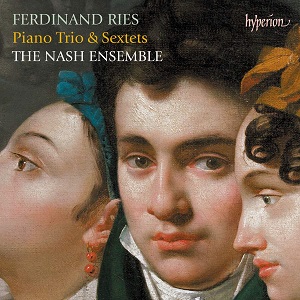
Ferdinand Ries (1784-1838)
Grand Sextet in C major, Op 100
Introduction and a Russian Dance for Cello and Piano, Op 113 No 1
Piano Trio in C minor, Op 143
Sextet in G minor, Op 142
The Nash Ensemble
rec. 2021, St. Silas the Martyr, Kentish Town, London
Hyperion CDA68380 [78]
Ferdinand Ries is finally starting to get some respect as a composer rather than just being known as one of Beethoven’s scant few pupils. This Hyperion disc adds to the increasing number of rediscovered works, as well as visiting a few works that have already been recorded by others.
The Grand Sextet in C major, Op 100, is really a piece for piano with a string quartet and a double bass along for the ride. All the action is entirely on the keyboard, with the strings getting very little of interest to do. In the first movement, there are a number of rapid close chords that definitely give the pianist a workout. The second movement of variations on an Irish air doesn’t respect the folksong origins of the theme; it turns into a rather inappropriate set of virtuosic classical riffs. Ries would have done well to have followed Beethoven’s example in his sets of variations on folksongs, Opp 107 and 109, which never lose sight of the homely origins of the themes no matter how they are varied. The third movement begins promisingly with a slow introduction and a jaunty moto perpetuo, which sadly gives way to a rather pedestrian theme ornamented by tiresome and repetitive ripples up and down the keyboard.
Ries fares better with the Introduction and Russian Dance for cello and piano, Op 113/1. Here, the cello part is handled with interesting sensitivity and allows cellist Adrian Brendel to very much wear his heart on his sleeve. The piano part appropriately retreats into the background here. I would have liked to hear a bit more liveliness in the Russian Dance, however, as we hear in Martin Rummel’s recording of this charming piece for Naxos.
Ries balances the elements more effectively in the Piano Trio in C minor, Op 143, with the violin and cello acting more like full partners even though the piano is still prominent. Ries’ penchant for the dramatic is on full display here. The best is saved for last, with a rollicking Finale that carries an infectious good humour.
Finally, in the Sextet in G minor, Op 142, Ries offers the rather unusual combination of piano and harp, accompanied by clarinet, bassoon, horn and double bass. The score provides that the harp can also be replaced by a second piano. Once again, the piano and harp take center stage and the other four instruments have very little to do for the most part until the finale, where they really get to shine in the middle section. That middle is one of the highlights of the disc, as the winds display a sense of fun missing from much of the rest of the recording.
The Nash Ensemble follows Ries’ metronome markings meticulously, which is good, but the meticulousness also has less pleasant consequences, especially when compared to the Franz Ensemble’s recording of the Sextet in G minor. Even though the engineering on the Hyperion disc is much cleaner and has better separation of instruments and presence, liveliness is somewhat lacking here. The Franz Ensemble is also more willing to play with rubato, which certainly helps their presentation feel more immediate. There’s nothing wrong with the Nash presentation, but it feels tepid by comparison.
On the positive side, the dynamic range is excellent, and the timbre of the individual instruments comes through nicely. The thin booklet contains some background about Ries and the works, with French and German translations of the English original.
Mark S. Zimmer
Previous review: David Barker (October 2022)
Help us financially by purchasing from




















